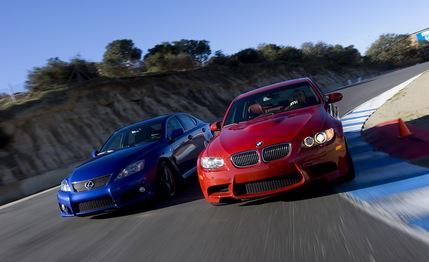
 Comparison Tests
Comparison Tests
“Competition,” said John D. Rockefeller, the founder of Standard Oil and an early poster child of the business monopoly, “is a sin.”
He’d certainly be horrified by the competition going on these days among the makers of sports sedans. To many, these are the jewels of the high-performance market, and yet they seat at least four and don’t require fortunes associated with Google stock.
Although the genre is deliciously broad, we’ll concentrate here on two cars: the cat’s meow of sports sedans, the BMW M3, and a newcomer from Lexus, the IS F. This fourth generation of the BMW M3 debuted last fall and is available as a two-door coupe, a four-door, and, coming soon, a convertible. Last December we pitted the new M3 coupe against the Mercedes-Benz C63 AMG and Audi RS 4 [“Gluttons for Punishment”], and the result was a rout for the Bimmer. Neither the Lexus, which only comes as a sedan, nor the four-door M3, was available for that test, so this duel was a given.
The IS F and the M3 cover the same basic formula, which is a lot like the muscle-car recipe from a bygone era. Start with a small, lightweight car, and stuff in a honking engine. The difference now is that these modern-day muscle cars complement those monster motors with sharp suspensions and plenty of luxury features. They’re not exorbitantly priced, but neither are they cheap. Both have base prices of about $56,000.
Let’s start with the M3. Based on the 17-time 10Best-winner 3-series, the latest M3 has twice the number of cylinders (eight) and, with 414 horsepower, more than twice the horsepower of the first M3 that debuted in 1988. Coupled to a standard six-speed manual transmission (a twin-clutch automated manual will be available this summer), the M3’s V-8 revs to an almost unheard-of 8400 rpm. Additionally, there are larger brakes, a firmer suspension, and enough body modifications to let the world know you’re in something special. Our test car came stuffed with options—adjustable shocks, steering assist, nav, heated seats, and various other bits—that swelled the as-tested price to $64,450.
Meanwhile, the Lexus IS F looks similarly capable on paper. It’s Lexus’s first über-version of the capable IS sedan, and the company has not scrimped. In the engine bay resides a 416-hp, 5.0-liter V-8 that has a significant torque advantage over the BMW (371 pound-feet versus 295). An eight-speed automatic transmission—it’s the only one available—sends power to the rear wheels. We initially lamented the absence of a manual box, but Lexus has souped up the automatic so that in the manumatic mode it shifts in 0.1 second, Lexus claims. The suspension was lowered and stiffened, six-piston front-brake calipers pinch larger 14.2-inch rotors, and 19-inch forged aluminum wheels fill wider fenders and wheel arches. Our test car came with one option, a $3990 Mark Levinson sound system and navigation package that bumped the as-tested price to $60,755.
These sedans are serious performance cars and as such require some room to wring them out. We spent a day lapping Mazda Raceway Laguna Seca’s 2.2-mile road course in Monterey, California. There, we sucked in our guts while plunging the cars down Laguna’s famous Corkscrew, a left-right combination that has a devilishly blind approach and exit. Get it wrong, and you’re in the wall.
We later ran through plenty of twisties, highway slogs, and our usual performance tests. In short, we indulged like automotive robber barons. And, yes, we loved every minute of it.